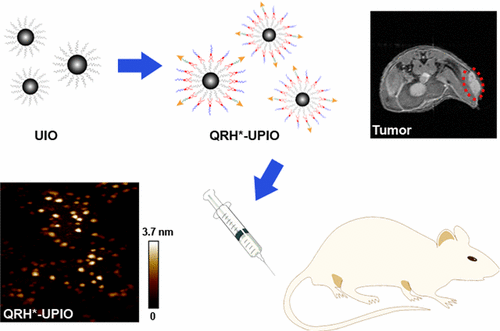当前位置:
X-MOL 学术
›
Bioconjugate Chem.
›
论文详情
Our official English website, www.x-mol.net, welcomes your feedback! (Note: you will need to create a separate account there.)
Ultrasmall Paramagnetic Iron Oxide Nanoprobe Targeting Epidermal Growth Factor Receptor for In Vivo Magnetic Resonance Imaging of Hepatocellular Carcinoma
Bioconjugate Chemistry ( IF 4.7 ) Pub Date : 2017-10-20 00:00:00 , DOI: 10.1021/acs.bioconjchem.7b00501 Yan Chen 1 , Quan Zhou 1 , Xue Li 1 , Fa Wang 1 , Kevin Heist 1 , Rork Kuick 1 , Scott R. Owens 1 , Thomas D. Wang 1
Bioconjugate Chemistry ( IF 4.7 ) Pub Date : 2017-10-20 00:00:00 , DOI: 10.1021/acs.bioconjchem.7b00501 Yan Chen 1 , Quan Zhou 1 , Xue Li 1 , Fa Wang 1 , Kevin Heist 1 , Rork Kuick 1 , Scott R. Owens 1 , Thomas D. Wang 1
Affiliation

|
Hepatocellular carcinoma (HCC) is a common worldwide cancer that is rising rapidly in incidence. MRI is a powerful noninvasive imaging modality for HCC detection, but lack of specific contrast agents limits visualization of small tumors. EGFR is frequently overexpressed in HCC and is a promising target. Peptides have fast binding kinetics, short circulatory half-life, low imaging background, high vascular permeability, and enhanced tissue diffusion for deep tumor penetration. We demonstrate a peptide specific for EGFR labeled with an ultrasmall paramagnetic iron oxide (UPIO) nanoparticle with 3.5 nm dimensions to target HCC using T1-weighted MRI. We modified the hydrophobic core with oleic acid and capped with PEGylated phospholipids DSPE-PEG and DSPE-PEG-Mal. The EGFR peptide is attached via thioether-mediated conjugation of a GGGSC linker to the maleimide-terminated phospholipids. On in vivo MR images of HCC xenograft tumors, we observed peak nanoprobe uptake at 2 h post-injection followed by a rapid return to baseline by ∼24 h. We measured significantly greater MR signal in tumor with the targeted nanoprobe versus scrambled peptide, blocked peptide, and Gadoteridol. Segmented regions on MR images support rapid renal clearance. No significant difference in animal weight, necropsy, hematology, and chemistry was found between treatment and control groups at one month post-injection. Our nanoprobe based on an EGFR specific peptide labeled with UPIO designed for high stability and biocompatibility showed rapid tumor uptake and systemic clearance to demonstrate safety and promise for clinical translation to detect early HCC.
中文翻译:

靶向表皮生长因子受体的超小顺磁性氧化铁纳米探针在肝细胞癌的体内磁共振成像中的应用
肝细胞癌(HCC)是世界范围内常见的癌症,其发病率迅速上升。MRI是用于HCC检测的强大的非侵入性成像方式,但是缺乏特定的造影剂限制了小肿瘤的可视化。EGFR在HCC中经常过表达,并且是有希望的靶标。肽具有快速的结合动力学,较短的循环半衰期,较低的成像背景,较高的血管通透性和增强的组织扩散能力,可深层穿透肿瘤。我们展示了特异于EGFR的肽,该蛋白用超小顺磁性氧化铁(UPIO)纳米颗粒标记,使用T 1靶向HCC的大小为3.5 nm加权MRI。我们用油酸修饰了疏水核心,并用聚乙二醇化磷脂DSPE-PEG和DSPE-PEG-Mal封端。EGFR肽通过GGGSC接头的硫醚介导缀合与马来酰亚胺末端的磷脂连接。在HCC异种移植肿瘤的体内MR图像上,我们观察到注射后2 h纳米探针的吸收峰值,随后约24 h快速回到基线。我们用靶向的纳米探针测量了明显更大的MR信号,而不是杂乱的肽,封闭的肽和Gadoteridol。MR图像上的分割区域支持快速的肾脏清除。注射后一个月,治疗组与对照组之间在动物体重,尸检,血液学和化学方面无显着差异。
更新日期:2017-10-20
中文翻译:

靶向表皮生长因子受体的超小顺磁性氧化铁纳米探针在肝细胞癌的体内磁共振成像中的应用
肝细胞癌(HCC)是世界范围内常见的癌症,其发病率迅速上升。MRI是用于HCC检测的强大的非侵入性成像方式,但是缺乏特定的造影剂限制了小肿瘤的可视化。EGFR在HCC中经常过表达,并且是有希望的靶标。肽具有快速的结合动力学,较短的循环半衰期,较低的成像背景,较高的血管通透性和增强的组织扩散能力,可深层穿透肿瘤。我们展示了特异于EGFR的肽,该蛋白用超小顺磁性氧化铁(UPIO)纳米颗粒标记,使用T 1靶向HCC的大小为3.5 nm加权MRI。我们用油酸修饰了疏水核心,并用聚乙二醇化磷脂DSPE-PEG和DSPE-PEG-Mal封端。EGFR肽通过GGGSC接头的硫醚介导缀合与马来酰亚胺末端的磷脂连接。在HCC异种移植肿瘤的体内MR图像上,我们观察到注射后2 h纳米探针的吸收峰值,随后约24 h快速回到基线。我们用靶向的纳米探针测量了明显更大的MR信号,而不是杂乱的肽,封闭的肽和Gadoteridol。MR图像上的分割区域支持快速的肾脏清除。注射后一个月,治疗组与对照组之间在动物体重,尸检,血液学和化学方面无显着差异。



























 京公网安备 11010802027423号
京公网安备 11010802027423号